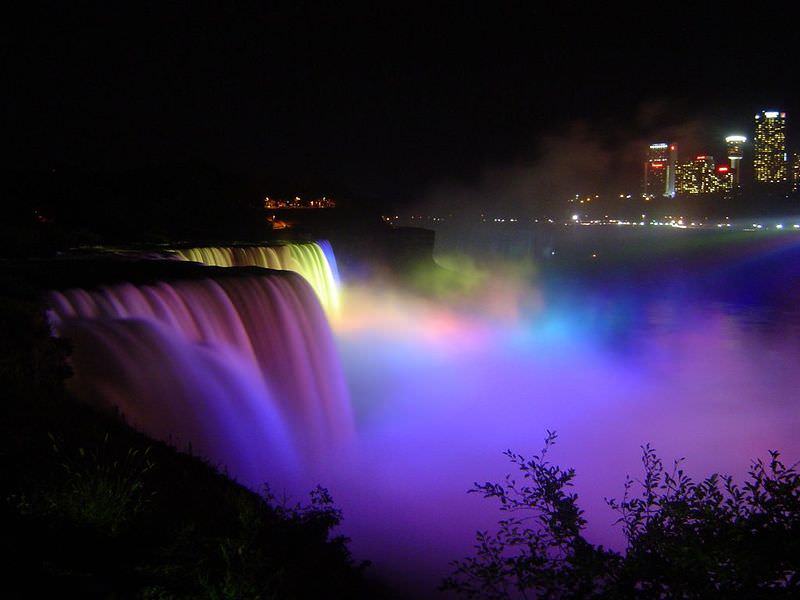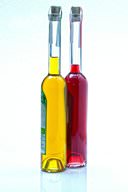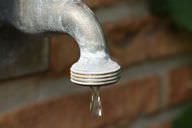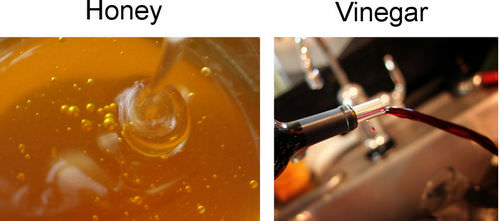2.13 液体
章节大纲
-
Colored by lights at night, an incredible amount of water plunges continuously over the sheer rock wall of Niagara Falls. If you stand close to the falls, the roar of the water is almost deafening, and the rushing water drenches you with spray. No wonder Niagara Falls was once named one of the seven natural wonders of the world! It’s amazing how such a common substance—water—can be so impressive.
::夜间的灯光笼罩着夜晚的光亮,大量的水不断涌过尼亚加拉瀑布的巨石墙上。 如果你站在瀑布附近,水的咆哮几乎震耳欲聋,而冲浪的水喷雾使你浑身发抖。 难怪尼亚加拉瀑布曾经被命名为世界七大自然奇迹之一。 如此常见的物质 — — 水 — — 竟然如此惊人。Water and Other Liquids
::水和其他液体Water is the most common substance on Earth, and most of it exists in the liquid state. A liquid is one of four well-known , along with , , and states. The particles of liquids are in close contact with each other but not as tightly packed as the particles in solids. The particles can slip past one another and take the shape of their container. However, they cannot pull apart and spread out to take the volume of their container, as particles of a gas can. If the volume of a liquid is less than the volume of its container, the top surface of the liquid will be exposed to the air, like the vinegar in the bottle pictured in the Figure .
::水是地球上最常见的物质,大部分存在于液态中。液体是已知的四种物质之一,与 、 和 以及状态。液体的颗粒彼此密切接触,但并不象固体中的颗粒那样紧密地包装在一起。粒子可以相互滑过,形成容器的形状。但是,它们不能分离和散开,以吸收容器的体积,因为气体的粒子可以。如果液体的体积低于容器的体积,液体的顶部表面将暴露在空气中,就像图中描绘的瓶中的醋一样。Q: Why does most water on Earth’s surface exist in a liquid state? In what other states does water exist on Earth?
::问题:为什么地球表面的大部分水都存在于液态中?地球在哪些其他国家存在水呢?A: Almost 97 percent of water on Earth’s surface is found as liquid salt water in the oceans. The over most of Earth’s surface is above the point (0°C) of water, so relatively little water exists as ice. Even near the poles, most of the water in the oceans is above the freezing point. And in very few places on Earth’s surface do temperatures reach the point (100°C) of water. Although water exists in the atmosphere in a gaseous state, water vapor makes up less than 1 percent of Earth’s total water.
::甲:地球表面的水近97%是海洋中的液化盐水。 地球表面大部分表面的水高于水的点(0°C ) , 冰的水相对较少。 即使在极地附近,海洋中的大部分水也高于冰点。 在地球表面的极少数地方,温度也达到了水的点(100°C ) 。 尽管大气中的水以气态存在,但水蒸气只占地球总水量的不到1%。Surface Tension and Viscosity
::表面紧张和动态Two unique properties of liquids are surface tension and viscosity. Surface tension is a force that pulls particles at the exposed surface of a liquid toward other liquid particles. Surface tension explains why water forms droplets, like the water droplet that has formed on the leaky faucet pictured in the Figure .
::液态的两个独特特性是表面张力和粘度。表面张力是将液体暴露表面的粒子引向其他液体粒子的一种力量。表面张力解释了为什么水状滴子会像图中所描绘的漏水水龙头上形成的水滴一样。Water drips from a leaky faucet. Viscosity is a liquid’s to flowing. You can think of it as between particles of liquid. Thicker liquids are more viscous than thinner liquids. For example, the honey pictured in the Figure is more viscous than the vinegar.
::粘度是液体流动的液体。 你可以把它想象成液体颗粒之间的液体。 锡克液体比稀薄液体更具粘度。 比如,图中描绘的蜂蜜比醋更粘度。Q: How does dish soap's viscosity compare to lemon juice?
::问:肥皂的粘度如何与柠檬汁相比?A: Lemon juice is typically less viscous than dish soap, meaning it has a thinner and less resistant consistency that can be observed when pouring or squeezing the liquids.
::答:柠檬汁通常比洗碗肥皂的粘度要低,也就是说,柠檬汁的耐抗性较弱,在浇灌或挤压液体时可以观察到。Summary
::摘要-
A liquid is a state of matter in which particles can slip past one another and take the shape of their container. However, the particles cannot pull apart and spread out to take the volume of their container.
::液体是一种物质状态,粒子可以相互滑过,形成其容器的形状,但是,粒子不能分离和扩散,以吸收容器的体积。 -
Surface tension is a force that pulls particles at the exposed surface of a liquid toward other liquid particles. Viscosity is a liquid’s resistance to flowing.
::表面张力是将液体暴露表面的粒子引向其他液体粒子的一种力量。 可见性是液体对流动的抵抗力。
Review
::回顾-
State the properties of matter in the liquid state.
::说明物质在液体状态中的特性。 -
What property of liquids explains why water beads up on the car surface pictured in the
Figure
?
::为何汽车表面的水珠会出现在图中?
-
Predict which liquid has greater viscosity: olive oil or motor oil (SAE 40). Then do online research to find out if your prediction is correct.
::哪种液体具有更大的粘度:橄榄油或电动机油(SAE 40),然后进行在线研究,以确定你的预测是否正确。
Explore More
::探索更多The Table shows the viscosity of water at different temperatures. Use the data in the table to answer the questions below. The meaning of the units of viscosity is not necessary to appreciate the relationship between temperature and viscosity.
::表格显示了不同温度下水的粘度。 使用表格中的数据回答下面的问题。 粘度单位的含义对于理解温度和粘度之间的关系是没有必要的。Temperature [°C] Viscosity [mPa•s] 10 1.308 20 1.002 30 0.7978 40 0.6531 50 0.5471 60 0.4668 70 0.4044 80 0.3550 90 0.3150 100 0.2822 -
Describe in words what the data in the table show.
::用文字描述表格中的数据显示的内容。 -
If you were to draw a line graph of temperature and viscosity, what would it look like? Make a rough sketch to show how it would look. (Assume that the x-axis represents temperature and the y-axis represents viscosity.)
::如果您要绘制一个温度和粘度的线性图, 它会是什么样子? 绘制一个粗略的草图来显示它会如何看起来。 (假设x轴代表温度,y轴代表粘度。 ) -
Write a hypothesis to explain the relationship between temperature and viscosity of water.
::写一个假设来解释水的温度和粘度之间的关系。
Resources
::资源 -
A liquid is a state of matter in which particles can slip past one another and take the shape of their container. However, the particles cannot pull apart and spread out to take the volume of their container.




